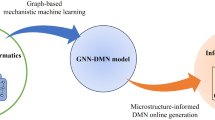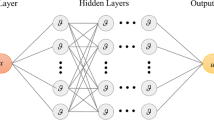Abstract
Granular materials are complex systems whose macroscopic mechanics are governed by particles at the grain-scale. The need to understand their grain-scale behavior has motivated significant experimental and modeling efforts. Bridging the grain-scale with the continuum scale is important in order to develop constitutive theories based on grain-scale behavior, as well as for interpreting the results of grain-scale models and experiments from a macroscopic context. In this work, we present a new data-driven framework based on convolutional neural networks to bridge the grain-scale and continuum scale in granular materials. We use this framework to obtain a micromechanical model of stress and demonstrate that spatial correlations at the grain-scale are critical for bridging length scales. Our results suggest that it is possible to learn data-driven relationships between the grain-scale and macroscale even if we have limited knowledge about the physical state of a granular system. We also observed that it is possible to train a model to predict macroscopic stress using only a subset of the contact data for each time step. This points to the discovery of a new pattern in granular systems, whereby any spatially correlated subset of contact data is sufficient to model macroscopic stress, regardless of how much force they may be carrying. Finally, we demonstrated that our framework is robust with potential for generalizability in time.













Similar content being viewed by others

Data Availability
Data were obtained from the work done by Marteau and Andrade [42].
References
Puzrin AM (2012) Constitutive modelling in geomechanics. Springer, Berlin
Andrade JE, Mital U (2019) Multiscale and Multiphysics Modeling of Soils. In: Lu N, Mitchell JK (eds) Geotechnical fundamentals for addressing new world challenges. Springer, Cham, pp 141–168
Alikarami R, Andò E, Gkiousas-Kapnisis M et al (2015) Strain localisation and grain breakage in sand under shearing at high mean stress: insights from in situ X-ray tomography. Acta Geotech 10:15–30. https://doi.org/10.1007/s11440-014-0364-6
Kim FH, Penumadu D, Kardjilov N, Manke I (2016) High-resolution X-ray and neutron computed tomography of partially saturated granular materials subjected to projectile penetration. Int J Impact Eng 89:72–82. https://doi.org/10.1016/j.ijimpeng.2015.11.008
Lenoir N, Bornert M, Desrues J et al (2007) Volumetric digital image correlation applied to X-Ray microtomography Images from triaxial compression tests on argillaceous rock. Strain 43:193–205. https://doi.org/10.1111/j.1475-1305.2007.00348.x
Semnani SJ, Borja RI (2017) Quantifying the heterogeneity of shale through statistical combination of imaging across scales. Acta Geotech 12:1193–1205. https://doi.org/10.1007/s11440-017-0576-7
Wildenschild D, Sheppard AP (2013) X-ray imaging and analysis techniques for quantifying pore-scale structure and processes in subsurface porous medium systems. Adv Water Resour 51:217–246. https://doi.org/10.1016/j.advwatres.2012.07.018
Cundall PA, Strack ODL (1979) A discrete numerical model for granular assemblies. Géotechnique 29:47–65
Iwashita K, Oda M (1998) Rolling resistance at contacts in simulation of shear band development by DEM. J Eng Mech 124:285–292
Jerves AX, Kawamoto RY, Andrade JE (2016) Effects of grain morphology on critical state: a computational analysis. Acta Geotech 11:493–503. https://doi.org/10.1007/s11440-015-0422-8
Kawamoto R, Andò E, Viggiani G, Andrade JE (2018) All you need is shape: predicting shear banding in sand with LS-DEM. J Mech Phys Solids 111:375–392. https://doi.org/10.1016/j.jmps.2017.10.003
Mital U, Kawamoto R, Andrade JE (2019) Effect of fabric on shear wave velocity in granular soils. Acta Geotech. https://doi.org/10.1007/s11440-019-00766-1
Mital U, Andrade JE (2016) Mechanics of origin of flow liquefaction instability under proportional strain triaxial compression. Acta Geotech 11:1015–1025. https://doi.org/10.1007/s11440-015-0430-8
Nicot F, Sibille L, Donze F, Darve F (2007) From microscopic to macroscopic second-order work in granular assemblies. Mech Mater 39:664–684
O’Donovan J, O’Sullivan C, Marketos G, Muir Wood D (2015) Analysis of bender element test interpretation using the discrete element method. Granular Matter 17:197–216. https://doi.org/10.1007/s10035-015-0552-6
Radjai F, Wolf DE, Jean M, Moreau J-J (1998) Bimodal character of stress transmission in granular packings. Phys Rev Lett 80:61
Rothenburg L, Bathurst RJ (1989) Analytical study of induced anisotropy in idealized granular materials. Geotechnique 39:601–614
Tordesillas A, Muthuswamy M (2009) On the modeling of confined buckling of force chains. J Mech Phys Solids 57:706–727
Bagi K (2006) Analysis of microstructural strain tensors for granular assemblies. Int J Solids Struct 43:3166–3184. https://doi.org/10.1016/j.ijsolstr.2005.07.016
Christoffersen J, Mehrabadi MM, Nemat-Nasser S (1981) A micromechanical description of granular material behavior. J Appl Mech 48:339. https://doi.org/10.1115/1.3157619
Rothenburg L, Selvadurai APS (1981) A micromechanical definition of the Cauchy stress tensor for particulate media. In: Selvadurai APS (ed) Proceedings of the international symposium on the mechanical behaviour of structured media. Elsevier, Amsterdam, pp 469–486
Zhu HP, Yu AB (2002) Averaging method of granular materials. Phys Rev E 66:021302. https://doi.org/10.1103/PhysRevE.66.021302
Li X, Yu HS, Li XS (2009) Macro–micro relations in granular mechanics. Int J Solids Struct 46:4331–4341. https://doi.org/10.1016/j.ijsolstr.2009.08.018
Goldhirsch I (2010) Stress, stress asymmetry and couple stress: from discrete particles to continuous fields. Granular Matter 12:239–252. https://doi.org/10.1007/s10035-010-0181-z
Kruyt NP, Rothenburg L (2004) Kinematic and static assumptions for homogenization in micromechanics of granular materials. Mech Mater 36:1157–1173. https://doi.org/10.1016/j.mechmat.2002.12.001
Chen H (2019) Constructing continuum-like measures based on a nonlocal lattice particle model: Deformation gradient, strain and stress tensors. Int J Solids Struct 169:177–186. https://doi.org/10.1016/j.ijsolstr.2019.04.014
Eliáš J (2020) Elastic properties of isotropic discrete systems: connections between geometric structure and Poisson’s ratio. Int J Solids Struct 191–192:254–263. https://doi.org/10.1016/j.ijsolstr.2019.12.012
Yan B, Regueiro RA (2019) Definition and symmetry of averaged stress tensor in granular media and its 3D DEM inspection under static and dynamic conditions. Int J Solids Struct 161:243–266. https://doi.org/10.1016/j.ijsolstr.2018.11.021
Nejadsadeghi N, Misra A (2020) Extended granular micromechanics approach: a micromorphic theory of degree n. Math Mech Solids 25:407–429. https://doi.org/10.1177/1081286519879479
Pedregosa F, Varoquaux G, Gramfort A et al (2011) Scikit-learn: machine learning in Python. J Mach Learn Res 12:2825–2830
Martín Abadi, Ashish Agarwal, Paul Barham, et al (2015) TensorFlow: Large-Scale Machine Learning on Heterogeneous Systems
Paszke A, Gross S, Massa F et al (2019) PyTorch: an imperative style, high-performance deep learning library. In: Wallach H, Larochelle H, Beygelzimer A et al (eds) Advances in Neural Information Processing Systems 32. Curran Associates, Inc., NY, pp 8024–8035
Ghaboussi J, Garrett JH, Wu X (1991) Knowledge-based modeling of material behavior with neural networks. J Eng Mech 117:132–153. https://doi.org/10.1061/(ASCE)0733-9399(1991)117:1(132)
Zhu J-H, Zaman MM, Anderson SA (1998) Modeling of soil behavior with a recurrent neural network. Can Geotech J 35:15
Wang K, Sun W (2019) Meta-modeling game for deriving theory-consistent, microstructure-based traction–separation laws via deep reinforcement learning. Comput Methods Appl Mech Eng 346:216–241. https://doi.org/10.1016/j.cma.2018.11.026
Heider Y, Wang K, Sun W (2020) SO(3)-invariance of informed-graph-based deep neural network for anisotropic elastoplastic materials. Comput Methods Appl Mech Eng 363:112875. https://doi.org/10.1016/j.cma.2020.112875
Yang H, Guo X, Tang S, Liu WK (2019) Derivation of heterogeneous material laws via data-driven principal component expansions. Comput Mech 64:365–379. https://doi.org/10.1007/s00466-019-01728-w
Goodfellow I, Bengio Y, Courville A (2016) Deep learning. MIT Press
Nielsen MA (2015) Neural networks and deep learning. Determination Press
Rumelhart DE, Hinton GE, Williams RJ (1986) Learning representations by back-propagating errors. Nature 323:533–536. https://doi.org/10.1038/323533a0
Kingma DP, Ba J (2017) Adam: A Method for Stochastic Optimization. arXiv:14126980 [cs]
Marteau E, Andrade JE (2017) A novel experimental device for investigating the multiscale behavior of granular materials under shear. Granular Matter 19:77. https://doi.org/10.1007/s10035-017-0766-x
Chollet F, others (2015) Keras. https://github.com/fchollet/keras
Oda M, Iwashita K (1999) Mechanics of granular materials: an introduction. Balkema, Rotterdam
Zeiler MD, Fergus R (2014) Visualizing and understanding convolutional networks. In: Fleet D, Pajdla T, Schiele B, Tuytelaars T (eds) Computer vision—ECCV 2014. Springer International Publishing, Cham, pp 818–833
Kim B, Kim H, Kim K et al (2019) Learning not to learn: training deep neural networks with biased data. 2019 IEEE/CVF conference on computer vision and pattern recognition (CVPR). IEEE, Long Beach, pp 9004–9012
Raissi M, Perdikaris P, Karniadakis GE (2019) Physics-informed neural networks: a deep learning framework for solving forward and inverse problems involving nonlinear partial differential equations. J Comput Phys 378:686–707. https://doi.org/10.1016/j.jcp.2018.10.045
Szegedy C, Liu W, Jia Y et al (2015) Going deeper with convolutions. 2015 IEEE conference on computer vision and pattern recognition (CVPR). IEEE, Boston, pp 1–9
He K, Zhang X, Ren S, Sun J (2016) Deep Residual Learning for Image Recognition. In: 2016 IEEE Conference on Computer Vision and Pattern Recognition (CVPR). pp 770–778
Long J, Shelhamer E, Darrell T (2015) Fully convolutional networks for semantic segmentation. 2015 IEEE conference on computer vision and pattern recognition (CVPR). IEEE, Boston, pp 3431–3440
Funding
The authors acknowledge funding support by Army Research Office, under Grant Number W911NF-17-1-0212.
Author information
Authors and Affiliations
Corresponding author
Ethics declarations
Conflicts of interest
The authors declare that they have no conflict of interest.
Rights and permissions
About this article
Cite this article
Mital, U., Andrade, J.E. Bridging length scales in granular materials using convolutional neural networks. Comp. Part. Mech. 9, 221–235 (2022). https://doi.org/10.1007/s40571-021-00405-1
Received:
Revised:
Accepted:
Published:
Issue Date:
DOI: https://doi.org/10.1007/s40571-021-00405-1



